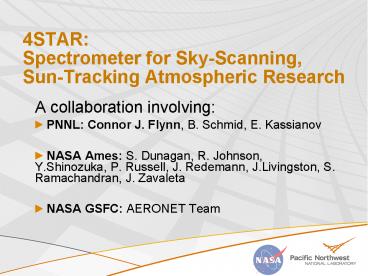4STAR: Spectrometer for Sky-Scanning, Sun-Tracking Atmospheric Research - PowerPoint PPT Presentation
Title:
4STAR: Spectrometer for Sky-Scanning, Sun-Tracking Atmospheric Research
Description:
Stray light rejection: measure skylight within 3 of sun ... Stray light near sun should be further reduced. Langley calibrations show variability ... – PowerPoint PPT presentation
Number of Views:57
Avg rating:3.0/5.0
Title: 4STAR: Spectrometer for Sky-Scanning, Sun-Tracking Atmospheric Research
1
4STAR Spectrometer for Sky-Scanning,
Sun-Tracking Atmospheric Research
- A collaboration involving
- PNNL Connor J. Flynn, B. Schmid, E. Kassianov
- NASA Ames S. Dunagan, R. Johnson, Y.Shinozuka,
P. Russell, J. Redemann, J.Livingston, S.
Ramachandran, J. Zavaleta - NASA GSFC AERONET Team
2
4STAR Spectrometer for Sky-Scanning,
Sun-Tracking Atmospheric Research
AATS-like capability Airborne sun-tracking
yields range-resolved properties from
column-integrated quantities measured while
profiling.
Improve gases And thus AOD Airborne spectra
yields profiles of aerosol type
3
Proposed 4STAR data products
- Direct beam W/(m2 nm)
- Aerosol Optical Depth, Extinction (via vertical
profiling) - Gases H2O, O3, NO2, CO2 (column and in profile)
- Angularly resolved sky radiance W/(m2 nm sr)
- Phase function
- Asymmetry parameter
- Aerosol Sphericity
- Size distributions
- Ambient aerosol absorption
- Single-scattering albedo
- Synthesis products
- Cloud OD, Reff (Barker et al.)
- Spectral range modular, but currently 350 nm
1.7 mm.
4
4STAR and its Use
5
AATS (Team) provides a bridge between orbital and
various suborbital sensors
- Satellite validation (aerosol, H2O, O3)
- AIRS (1), ATSR-2 (2), AVHRR (4), GMS (1), GOES
(2), GOME (1), MISR (5), MODIS (10), POAM (2),
SAGE-3 (2), SeaWiFS (1), TOMS (2) - Airborne satellite simulators (4)
- Airborne in situ aerosol (13)
- Lidars surface (10), airborne (4)
- Radiative Forcing with Pilewskie SSFR (4)
- Atmospheric Correction (2)
- Model predictions of aerosol profiles (1)
- Surface Albedo (1)
- (70 peer-reviewed publications since 1996)
6
NASA Ames Airborne Tracking Sunphotometers13
Field Campaigns Since 1996
- TARFOX
- 2 WVIOPs
- ACE-2
- PRIDE
- SAFARI-2000
- ACE-Asia
- CLAMS
- SOLVE II
- Aerosol IOP
- EVE
- INTEX-A
- ALIVE
7
AATS-14
AATS-6
8
Spectrometer for Sky-Scanning, Sun-Tracking
Atmospheric Research (4STAR)
Optical Entrance
Sun Tracking Head
9
Ground Prototype (4STAR-Ground)
10
Key Technological Hurdles
- Fiber optic couplings with lt1 calibration
stability (Connections/Rotation) - Irradiance calibration to 1 over a period of
months. - Radiance calibration to a few percent.
- Stray light rejection measure skylight within 3
of sun - Sky scan within 100 seconds (10 km in flight)
11
Rotating Fiber Optics CouplingThroughput
Repeatability
12
Radiance Calibration
13
4STAR-Ground
AERONET Cimel
Jens Redemann
Roy Johnson
14
4STAR and AERONET principal plane scan
15
Stray light rejection close to Sun
16
Size Distribution Retrieval using AERONET Code
17
Sun Photometer Inter-Comparison Experiment
(SPICE) Mauna Loa, Aug. 24-Sept. 2 2008
4STAR Prede AATS-14 Cimel 037 Cimel 101 Cimel 451
18
Mauna Loa Sun Photometer Inter-Comparison
Experiment (SPICE)
- Why Mauna Loa?
- High altitude (3.4 km), low aerosol loading (in
morning) - Intense direct beam, low sky brightness
- ? Good Langleys for sun channel calibration
- Compare Langley calibrations of AATS-14, Prede,
4STAR and Cimel photometers - Also provides a stringent test for radiance
measurements with atmospheric conditions similar
to flight conditions - Confirm sufficient radiance signal levels.
- Compare sky radiances from 4STAR, Prede, and
Cimels.
19
(No Transcript)
20
Radiance comparison conclusions
- Radiance calibration and repeatability is
sufficient. - Radiance signal levels are strong, permitting
fast sky scans, 1 sec/angle - Stray light near sun should be further reduced.
21
Langley calibrations show variability
22
(No Transcript)
23
(No Transcript)
24
Langley comparison conclusions
- 4STAR Langley calibrations show acceptable
relative stability (with respect to wavelength)
but insufficient day-to-day stability. - Temperature sensitivity as possible source
- Dark counts exhibit temperature variability
- Possibly a temperature-dependent gain.
- Enclosing spectrometers in temperature controlled
box. - Small light leak might contribute to instability
as well.
25
Next steps
- Add SWIR 900 nm -1700 nm spectrometer for more
size and absorption information - Reduce stray light in skylight measurements
- Provide temperature stability
- Eliminate light leak
- Continue spectral inversion development
- Harden design for airborne deployment
26
Funding outlook
- NASA and Battelle/PNNL internal bridge funding
- NASA ROSES proposal is pending
- If successful, this will carry us to a
configuration for unpressurized airborne
operation. - Requesting support for final hardening sufficient
for pressurized airborne operation, test flights,
and for participation in Western Atlantic
Tropospheric Aerosol Campaign (WATAC) 2011 or
similar.
27
- End of Presentation
- Remaining Slides are Backup
28
(No Transcript)
29
Direct Beam Comparison
AATS-14
4STAR-G
30
Direct Beam ComparisonAATS-14 4STAR-Ground
- Tracking stable enough
- Short term calibration is okay.
31
(No Transcript)































